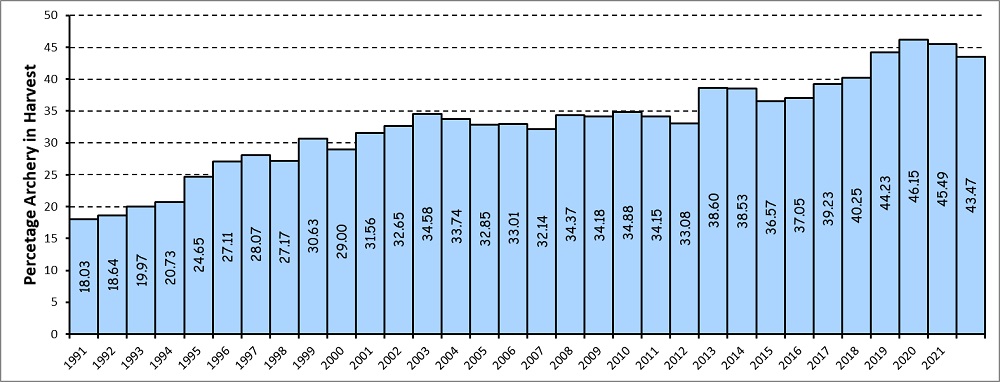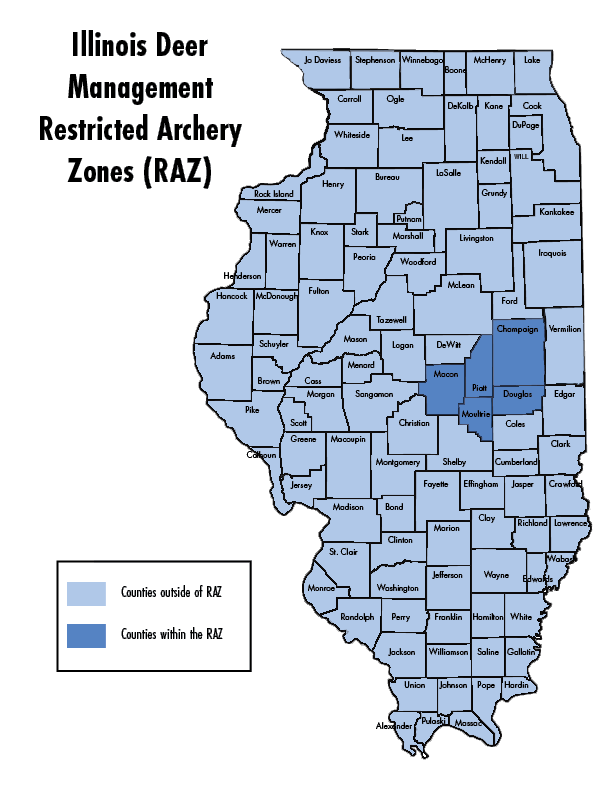Photo by Steve Beltran


Restricted Archery Zones a Deer Management Tool

Responsible white-tailed deer management is of upmost importance to the Illinois Department of Natural Resources (IDNR) – Division of Wildlife. It is our mission to manage deer populations towards county specific goals, in some counties we try to increase populations, in others we aim to decrease them. We monitor deer populations indirectly by annually evaluating information about where the population is trending and including biologist recommendations. Population trends are measured by several relative abundance indices including Deer Vehicle Accidents (DVA, the number of accidents with greater than $1,500 damage/billion miles driven in that county), hunter success, hunter effort, and crop damage in each county.

While managing deer populations, first we also consider hunter opportunity in management decisions and try to provide chances for all types of hunters to harvest deer. Historically, firearms have been the primary method of harvest in Illinois and population goals were met by manipulating the amount of firearm permits available. Antlerless-only permits, although they can be used to take male fawns, primarily result in harvesting does who are the drivers of population growth in white-tailed deer. In counties where we’d like to increase deer populations, we would decrease the availability of antlerless-only permits. Deer populations in some counties, however, have remained well below goal even though total firearm permit numbers have been reduced and antlerless-only permits have been set to zero. Growing deer populations in these counties will require a reduction in doe harvest, yet firearm hunting opportunities are already restricted. For the sake of balance, we must look at changes to other seasons if we are to grow deer populations toward county goals.
The popularity of archery hunting in Illinois has steadily increased through time. Statewide archery harvest peaked at a record high of 75,106 deer harvested in 2020, representing 46 percent of the total harvest (Figure 1). This increase in harvest is partially due to archery permits being sold as a combo (either-sex and antlerless-only) and the fact that permits are unlimited for in-state hunters. Additionally, as a result of 2017 legislation that removed restrictions on their use, crossbows are treated just like any other type of bow during hunting seasons. Crossbows now account for more than 50 percent of archery harvest and anecdotal evidence suggests that many firearm hunters are switching to crossbows.

The increase in archery harvest, however, has not been uniform across the state. In some counties deer populations are well below goal yet traditional management practices are ineffective because increased archery harvest is compensating for the restriction in firearm permits. County specific archery regulations that protect antlerless deer were needed to both grow the deer population and continue to provide opportunity for firearm hunters.

IDNR-Division of Wildlife initiated the Restricted Archery Zone (RAZ) in 2018 to address these management needs. The RAZ consists of five east-central Illinois counties (Champaign, Douglas, Macon, Moultrie, Piatt) where limited habitat makes the deer population vulnerable to overharvest. Hunters in these counties are prohibited from harvesting antlerless deer during the first 15 days of the Illinois archery deer season with no restriction on antlered deer. The prohibition on antlerless harvest is designed to protect female deer while not reducing the opportunity for hunters to take to the field and hunt. Since 2018, the proportion of bucks in the harvest has increased and relative abundance indices have increased (DVA, Figure 2) suggesting that the deer population is growing in the RAZ. This has allowed deer managers to increase firearm and muzzleloader permit quotas in three of the five RAZ counties for the 2023-2024 hunting season. While still in early stages, limiting harvest on antlerless deer for part of the archery season may be helping increase deer populations and balance hunter opportunity.
IDNR-Division of Wildlife is contemplating expanding the RAZ to include counties exhibiting similar trends in deer population and archery harvest in subsequent years. Counties of concern include Tazewell, Mason, Logan, Morgan, Scott, Greene, Edwards, Wabash, Alexander, Pulaski and Massac. These counties have already had their antlerless-only permits cut to zero with no response in population indices. There will be no changes to the RAZ for the 2023-2024 hunting season.
Follow IDNR’s deer website and Hunt Illinois for information and updates about deer hunting in Illinois.
Peter Schlichting is the Deer Project Manager with the Illinois Department of Natural Resources.
Peter Schlichting is the Deer Project Manager with the Illinois Department of Natural Resources’ Division of Wildlife Resources.
Submit a question for the author
Question: My neighbor in(Kane county) lets some gutters hunt deer coming out of the forest preserve nest to his house. Is this legal. I know he got a buck last night. And has killed coyotes too
Question: The hunting information sheet that comes with permits says changes are being considered to the restricted zones the first 15 days and to check back…….so were there changes?
Subscribe to our Newsletter
Explore Our Family of Websites
Similar Reads
A Century of Conservation: How Illinois Brought Back the White-tailed Deer
November 3, 2025 by Kaleigh Gabriel
The 2025-2026 Upland Hunting Forecast
November 3, 2025 by Don Kahl
Gardner Camp’s Kid’s Trapping Camp Helps Ensure Trapping’s Future
November 3, 2025 by Tim Kelley
The Bowfin: Illinois’ Living Fossil
November 3, 2025 by Gretchen Steele
Illinois Waterfowl Hunting 2025-2026 Forecast
November 3, 2025 by Doug McClain
Return of the Giants: The reintroduction of alligator gar to the Cache River
November 3, 2025 by Mark Denzer, Rob Hilsabeck
The Sport Fish Restoration Act Has Been Supporting Fisheries Management for 75 Years: Part 2
November 3, 2025 by Vic Santucci
The Sport Fish Restoration Act Has Been Supporting Fisheries Management for 75 Years: Part 1
November 3, 2025 by Vic Santucci
Why the Long Face: What is up with the big nose on paddlefish?
November 3, 2025 by Shasta Kamara, Cory Suski
A Wild (Turkey) Century of Recovery
November 3, 2025 by Kathy Andrews Wright